|
Posted by Romy the Cat on
05-02-2008
|
|
I was wondering what the noise of stereo signal come into FM and are any ways to reduce it? Naturally we get out stations in mono mode with practically no noise at all. The best tuners more then 85dB signals to noise ratio – that are very high number and the typical hiss the we get in stereo is not even closed to the electrical signal-to-noise characteristics of out tuner. So, why we even have to have the FM Stereo Noise? Is it the fundamental entity of FM reception of juts bad implementation of some specifics?
I would not consider the minor FM noise is destructive – in fact I kind of like it – it has a slight dithering effect but I still wonder….
In my experience the same stations of excellent reception might have fluctuation on FM stereo noise depending of:
1) How the station broadcasts
2) Atmospheric condition
3) Precision of tuning to the stations
4) The multipath level
5) The characteristics of the tuners
If with the first 4 parameters everything is understandable then with the last parameters the things are perplexed. All front ends have own noise capacity but how about the stereo decoders? If I run a tuner in mono and have no FM noise then I presume that my frond end and IF sections are fine. As soon I activate the stereo decoding I get noise – so would it be the stereo extraction itself that screw the things up?
Well, we have a number of different topologies the phase locked loop stereo decoders, the pulse-count stereo decoders etc. We have integrated devised and discrete stereo decoders. We have tubes, hybrid and SS stereo decoders. They all produce different sound but are they the primary source of the FM noise in stereo? If so then is it possible to make the MPX stereo extractors better in order to have lover FM stereo noise? Rgs, Romy the caT
|
|
|
|
Posted by Romy the Cat on
05-03-2008
|
|
The sound in tuner is born in intimidate frequency stage. Still it looks like the Sound of tuner is still mostly described by stereo decoder and output stage. I have two Sansuis TU-X1 that have against the certain station virtually identical sound. I said “virtually” because the delta that is there is irrelevant for the experiment. So, I driver the TU-X1 multiplex decoder from Sansui’s own intimidate frequency and another TU-X1 with totally another tuner. The other tuner has completely different way more sophisticated and immuned from overload front-end (10 gang tube-based, nuvistors) end completely different, nightly elaborate intimidate frequency stage. The set the input voltage to the Multiplex-only TU-X1 identical to what Sansui was getting from own IF stage. Can you predict the result?
Wrong, the full TU-X1 and the Multiplex-only TU-X1 sound identical. I mean there is a minor difference but this difference is exactly the delta that I decried above as “virtual”. What does it say? That says that it should be given more attention to Multiplexing and out stage. To settle the thing I am experimenting with discrete tubes Multiplex decoders, who knows, perhaps the switching discrete decoders would be more interesting sonically. The minor problems that I have that I do not have any objections in regards to Sound I am getting out of the TU-X1’s Multiplex and output stage…
The Cat
|
|
|
|
|
|
|
Posted by Romy the Cat on
05-04-2008
|
 peter foster wrote: peter foster wrote: | |
Thanks Peter.
Yep, the decoder in there is a regular switching type. It is very interesting that the guy state in his comment:
“The sound quality does not change when switching from stereo FM to mono FM except that the the stereo signal
gives good stereo imaging…”
I wonder what happen to noise level. Dima spent a lot of time to explain to me some very rudimental mathematics of stereo extraction in FM. He described many topologies and sub- topologies how it might be done and insist that from mathematics point of view the stereo quality and noise live for ether multiplex method should produce identical result. He also enplaned why increase signal to noise ratio in FM stereo is built within the FM principle. However, he feels that implementation of the stereo decoding still have impact to the amount and quality of the noise. That is why I wonder…
Anyhow, here are a few useful pointers. Our Sansui TU-X1 uses Phase Locked Loop decoder made around the HA-11223W chip. This is archaic chip and there are many contemporary substitutes. I presume that they all sound different. I have no idea what it good or bad but I like how the TU-X1 sounds. So I presume that it is a good sounding chip. Here is a rare datasheet for this chip that hive a very good picture how it works.
http://www.goodsoundclub.com/pdf/MultiplexDecoder11223W.pdf
The switching stereo decoder, as described in the link you provided, it very well explained in the following link:
http://www.goodsoundclub.com/pdf/EicoMX99.pdf
I do have a classic switching Multiplex decoder made by Ampex that uses 4x12AX7 (8 halves) and I am trying to figure out what of produce more interning result. Still, I would like to learn if (regardless of the implantation that I happened to use) one or another topology of stereo extraction is more promising. I even thought to record the full bandwidth along with the 19kHz pilot and with the up to 70 Ha side-band and then to do stereo decoding at digital level, similar to the way how the Accuphase T-1000 does. There are some technical cones and pros in this way. I did not have T-1000 and I heard 3 absolutely contradictive feedbacks from T1000 owners.
http://www.accuphase.com/model/t-1000.html
Anyhow, the digital stereo extraction is also might be considered… Rgs, Romy the Cat
|
|
|
|
Posted by Romy the Cat on
05-06-2008
|
|
After exploring the options for Multiplexing decoding on digital domain I decided to downgrade this perspective for now. Here are some cone and prose of Digital Multiplexing as I can see them
Pros:
- Ability to have better noise performance. This is till debatable as Digital decoders have 80-85dB signal- to-noise ratio while the do stereo extraction from the composite signal. The well done analog multiplex decoders can do 85dB s/n as well…
- Ability to eliminate analog output stage in case the FM broadcast goes straight to recording (like in my case)
- Precision of implementation and extraction. Stability of filters. No need for alignment.
Cons:
- Presence of additional DSP engine in signal path right along with its all peripherals: buffers, data acquisition stages, clocks synchronizers etc…
Now about the options. Unfortunately it is not a lot. I was not able to found a good D-to-D processor that would take composite signal and will split it to stereo. It should be a card that might be added to PC. Still, considering that I would be probably the only person in the word why would express an interest to buy it and considering the perceives of analog FM I doubt that this card will ever be made. Even if it were made than I still would have a problem as to feel this thing will be necessary at least 172kHz composite digitalized signal (Multiplexing has own bandwidth up to 60kHz)
What is more available are a number of solutions that takes analog Multiplexing and spit out stereo AES/EBU stream. One of better examples is Belar DSD-1 FM stereo decoder.
http://www.belar.com/ib/DSD-1%20User%20Guide%20Full.pdf
However this unit outputs 48kHz at 16Bit. If the 48kHz is fine then who the hell needs 16Bit?! The same processing is done in Accuphase T-1000 and spiting 48/ 16 – a major step back. Even if the digital stereo decoders start output truly 20Bit then the biggest problem in them would be: how doo the internal A/D converters. I presume that the internal A/D will be “instrumental level” with no regard to sound. Of course they are juts speculations and I would very much love to see a digital multiple with integral A/D converters that would much the sound quality of Pacific Microsonics but something suggests me that it will not be the case. Was it my common sense?
Anyhow, BELAR Electronics Laboratory
http://www.belar.com/
will come in the end of this year with a new D-to-D multiplex decoder that might do 24Bit output. I might try it… For the time being I will close the door on the idea of digital multiplexing and will stay with analog MPX converters feeding with them my “tested” A/D processors… Rgs, Romy the Cat
|
|
|
|
Posted by Romy the Cat on
05-06-2008
|
|
Continue in my journey to found an optimum solution for Multiplex stereo decoder I made today some experiments with Ampex multiplex decoder with intention to see if it would be able to offers any advantages over Sansui’s HA11223W-based PLL multiplex.
It is the very much original Ampex with all original parts and I decided to use it as is, though quite a few thighs might be improved in this decoder. Ampex is a discrete tube based devise that takes advantage not of the sum and difference of the signal individually for each channel but rather the time-multiplex aspect of stereo signal. With all simplicity of the Ampex’s circuit it has some kink. Most of the similar decoders had a set of diodes the toss signal right and left. The Ampex has a pair of the diodes sets and they toss signal to the right channels or ground it. This way the signal for a given channel does not flow through those diodes – very slick and reminds a shunt regulator in way….
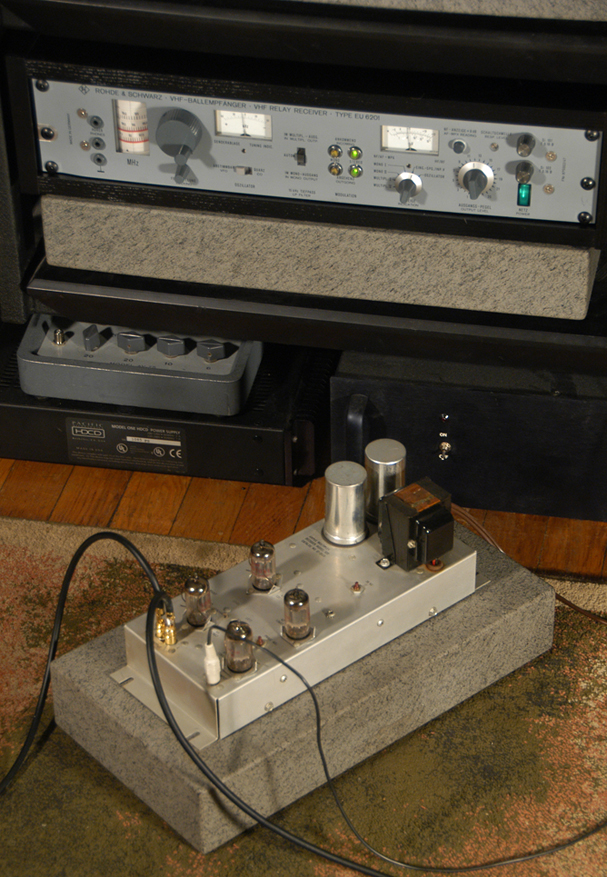
So I was using the composite mono signal from two sources: the Sansui’s TU-X1 Intermediate Frequency stage and from the none-filtered wide bandwidth output of Rohde & Schwarz EU-6201 FM Broadcast Relay. The composite signal from those two courses I fed into ether TU-X1’s own PLL decoders and output stage or to the Ampex’s phase-multiplex decoder.
The TU-X1’s decoder if very finicky and it wants only very precise max amplitude. So, I needed to attenuate the Rohde & Schwarz’s over 24dB to set the as they call it “synergy”. Anyhow, after EQ the volumes and do all necessary preparations I make the experiment methodological clean I was able to listen it.
I do not what to write a long post about it and will make it very short. It was no rivalry or even an attempt to compete: The TU-X1’s PLL decoder and output stage juts obliterated Ampex in each imaginable competition… The TU-X1 sounded as… the TU-X1. The Rohde & Schwarz through the TU-X1’s multiplex decoders sounded very similar. However, both tuners, feeding the Ampex decoder sound like shit.
Well, I kind of a good result as all the I need to do now is what I intended to do to begin with: to make in Sansui TU-X1 an extra input feeding the output stage with externals MPX signal from the Schwarz and to implement a switch between the sources. The very good part is that in this configuration I would have no need to use nether two A/D possessors nor to re-plug the cables from tuners to A/D.
Well, I know that it would be VERY difficult to beat the TU-X1 out stage I hardly heard from any other electronics this result, did I mention the consumer-level, cheap mass market electronics? So, just in case I bought a half dozen of the HA11223W chips…. Rgs, The caT
|
|
|
|
Posted by Romy the Cat on
06-23-2008
|
|
Keeping harassing different people bout the most interesting options for multiplex decoder for my Rohde & Schwarz EU-6201 I was wondering if it makes sense to me to use the Rohde. It is a very good tuner but it is not necessary result in better sound that I got from Sansui TU-1X. My antenna setting is optimized for Sansui’s idiosyncrasies (read limitations) and paying with antenna setting I was able to get from Sansui similar to the Rohde & Schwarz quality of reception in wide mode. Rohde did fine driving my second “experimental” Sansui’s TU-1X MPX decoder but after many tests I feel that my fist TU-1X juts sounds better and I do not want to modify it to accent the Schwarz’s external composite signal – I do not want to lose accidently what my first TU-1X does as I feel that it is unique in a way.
Recently talking to Dima about the options to use or not to use the Schwarz and collaborating the MPX decoders, Dima mention that Yamaha T-85 has a very interesting decoder. He feels that is it very elegantly designed from his perspective and it might be interesting. I took the Yamaha T-85, it turned out to be a nice tuner with not especially attractive sound show to Dima the circuit and he proposed that it will take 60 minutes to converts it into a standalone multiplex decoder. The way how the tuner made it is so ease and accessible that it took for me 15 minutes. I made just a few modifications in order to connect the Rohde & Schwarz wide-bandwidth output (7V!!!) and trash all Yamaha output muting section. I did not use anything else like change op-amps, resistor caps for something better – it was just basically stock Yamaha tuner with a surgically injected compose signal from outside right after the Yamaha’s Intermediate Frequency section. I use the chipset cables possible, inciting the 1M Multiplex cable from Rohde & Schwarz to Yamaha’s new made Multiplex input. I got rid the caps after the Yamaha out stage – it has 95mVDC – who cares!
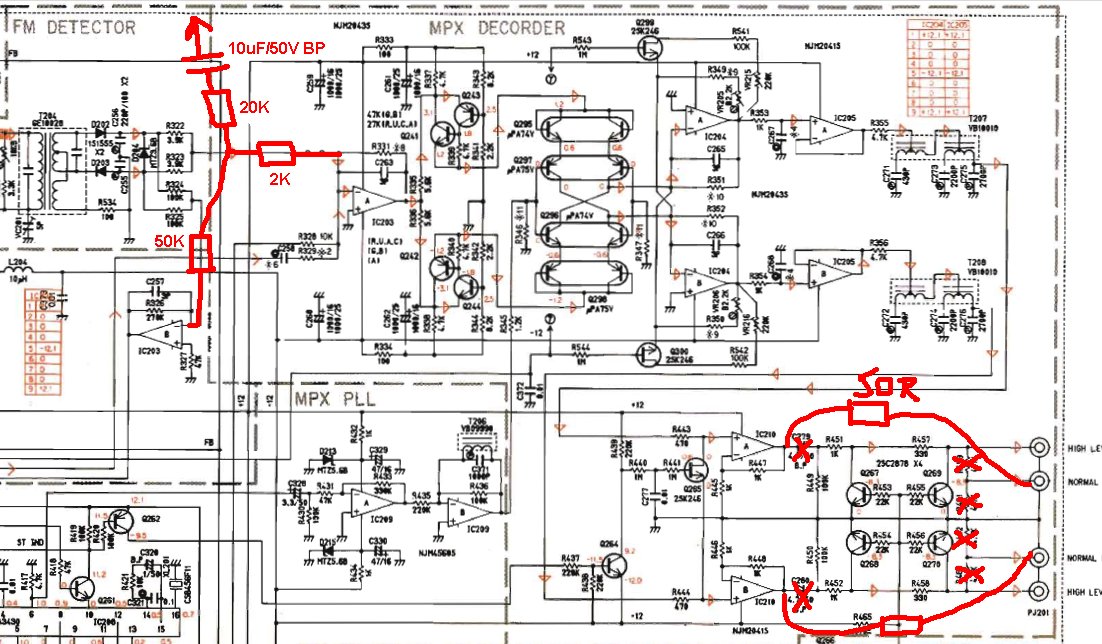
OK, here is the story… it sounds beautiful. I actually can’t believe how nice it is. My initials feeling that the Yamaha T-85’s MPX decoder actually sounds better then TU-1X’s decoder. Would you believe me if I say that it has more bass and more dynamic? I did not listen it very careful as I have no worthy programming tonight and I have to run now but the initial sentiments of using the Yamaha T-85 as the Rohde & Schwarz’s multiple is VERY positive. I need to do more test, including running my transmitter into both tuners and do some measurements but so far is very promising…
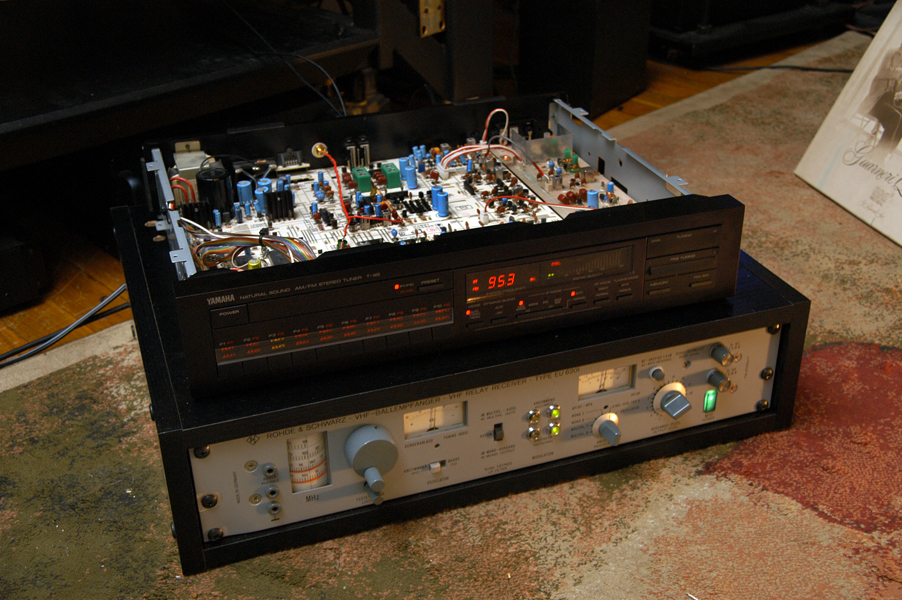
The Cat
|
|
|
|
|
|
|
Posted by Romy the Cat on
06-26-2008
|
|
I made further experiments and listening and now I have concluded that I am very comfortable Yamaha T-85 Multiplex decoder and I have sold it to use it as a default multiplex for Rohde & Schwarz EU-6201. I made a few modifications in T-85 Multiplex:
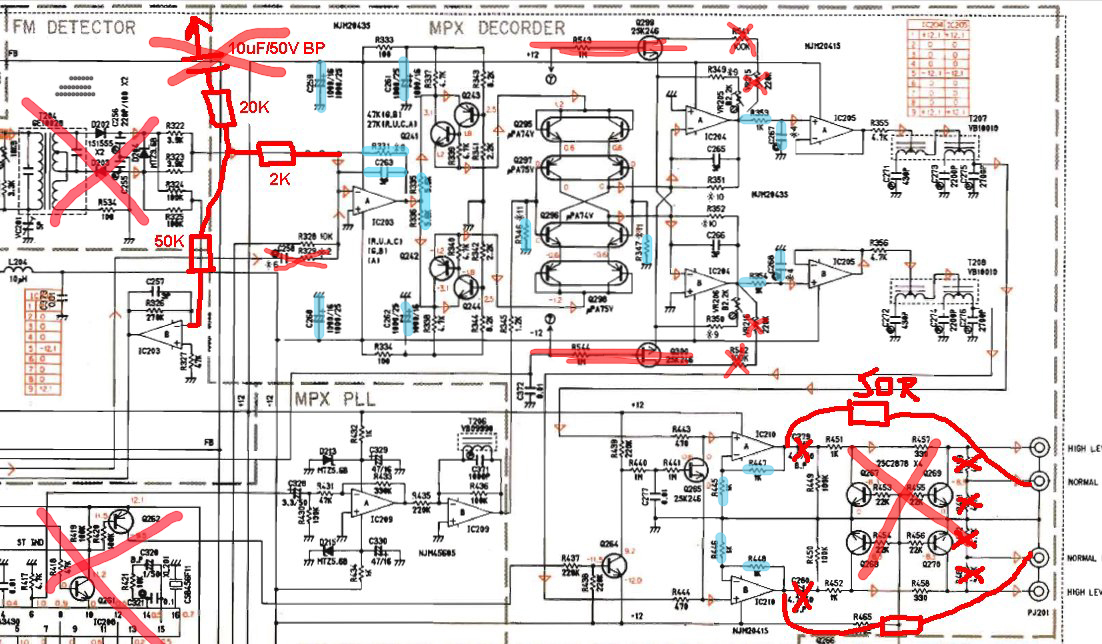
1) Eliminated AM access to Decoder
2) Eliminated muting section
3) Eliminated capacitance coupling with output
4) Very dramatically droped output impedance
5) Eliminatee input capacitor - there is no DC from Rohde & Schwarz
6) Replaced all important caps and resistor in the T-85 circuit with RN55, Muse …. (marked as blue)
7) Eliminated the dependency of channels separation what T-85 switch to super-wide mode
8) Max out the Pilot signal's attention
9) Recalibrated the channels separation based upon the Rohde & Schwarz’s composite signal
10) Added a jack for composite signal input
It ended up-to to be a very beautiful, completely-direct coupled circuit.
As now the Rohde & Schwarz + T-85 sound just wonderful and I would not look for other Multiplex Decoders with exception of a future idea to built one even better (with L de-emphasize) INSEDE of the Rohde & Schwarz. So, effectively so far the Decoder project is over. Probably the most reasonable question would be to ask how the Rohde & Schwarz + T-85 Decoder sound in relation to TU-1X. I have the judgment and it is much unexpected judgment at least to me. I will post it later on in the Rohde & Schwarz’s thread along with some commentaries.
http://www.romythecat.com/Forums/ShowPost.aspx?postID=7369#7369 The Cat
|
|
|
|
Posted by Romy the Cat on
07-22-2008
|
|
I mean to make this post with the observations for a number of weeks. The days are passing by and I hoped that I might get deeper to the bottom of it. Unfortunately I was not able to.
So, the Rohde & Schwarz EU-6201 is feeding a modified Yamaha T85 Multiplex decoder from one side. (There were other change in T85 – in the PS – they are not visible on the circuit above). From another side there is the TU-1X with own stock Multiplex decoder. Which one has better stereo? That question I asked myself many times trying to discard any other differences those FM setups have.
Well, the T85++ and TU-1X Multiplex decoders do produces a different stereo. Tonight the WCRB broadcasted my favorite Kalinnikov’s Symphony #1 with Jarvi leading Scottish National Orchestra (Chandos Records CHAN-8611). After the 100s times of listing this I was not able to help myself to hear it again in full Macondo's blume. Is anything might be more magnificent then VERY LOUD play of THAT first movement!!! Both Schwarz and Sansui were on (I never show down Schwarz – it is on all time) and I flipped the buttons on my preamps input…
Yes, I do detect the minute deference in stereo presentation but I honestly can’t say that one is better. They are different and each one then in own way good. The Schwarz-T85 has a very slightly more extended HF that makes the stereo imaging comparing not truly objective. However, I have no problems with ether of the stereo decoders…
Ok, I do admit that either T85’s or TU-1X’s are not the “intellectualy absurd” type of the stereo decoders - something to which I generally accustom in my audio solutions. Knowing me you should not doubt that the “intellectualy absurd” decoder will be coming. For now, I have to acknowledge that both T85’s and TU-1X’s MPX Decoders are very fine, different but very fine. It is highly possible that the “End of the Life” FM stereo decoder will not be better then what either T85’s or TU-1X’s decoders do cruelty. Well, perhaps there is no room for it in terms of sonic results… it is what I hope… The Cat
|
|
|
|
Posted by Romy the Cat on
08-04-2008
|
 Romy the Cat wrote: Romy the Cat wrote: | | Well, the T85++ and TU-1X Multiplex decoders do produces a different stereo. |
|
It was quite phenomenal FM program this weekend in Boston. I was running it mostly off the Sansui tuner and again and again I was stunned how good stereo imaging with this beast. Since I am in progress of building up the requirements and specifications for my own reference decoder I was thinking about the TU-X1’s stereo results. Wondering about the TU-X1’s stereo look at the TU-X1 service manful and noted a strange thing. The TU-X1’s frequency response was from 20Hz to 18kHz. That was kind of strange as usually all stereo tuners are marked up to 15Hz as they need to run minus 40-70dB filer at 19kHz to kill the pilot signal. I begun to look deeper into what Sansui does in TU-X1 and I found something that would explain it.

|
|
|
|
Posted by Romy the Cat on
08-09-2008
|
 Romy the Cat wrote: Romy the Cat wrote: | | …Knowing me you should not doubt that the “intellectualy absurd” decoder will be coming. |
|
If you read this thread then you know that the idea of the assaulting MPX decoder was bring in my mine. The ides was around the TU-1X’s decoder only with a few modifications:
1) Full sinusoid Pilot cancelation
2) Inductive de-emphasize in return loop
3) Better output stage
4) Better built and etc…
However, lately I decided to put the project on hold, or perhaps consider it’s cancelation as I was playing with another decoder that looks like deliver very interesting result. The decoder need some work to sound fine, it is what I am doing with it, but the potentials are all in there. It is Rohde & Schwarz’s own first version of their MSDS stereomessdecoder – an interesting unit. To my surprise it is fine sounding decoder but I need some further well defined sonic refinements. If I make it to sound in the way I would like it to sound then I will publish more detail report. Still something suggests me that it might end up exceptionally good that end up my interest in multiplex decoders.
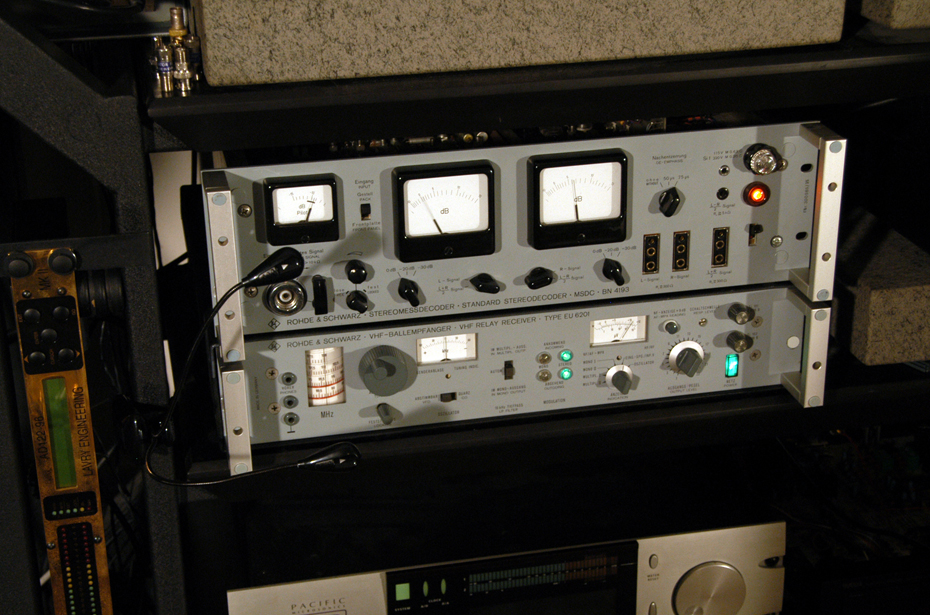
The Cat
|
|
|
|
Posted by Romy the Cat on
08-13-2008
|
|
What an incredibly cool result!!! I retrofitted the Rohde & Schwarz decoder with a few changes and it throw a very very very nice sound, in fact even better then I predicated. The Decoder has a SS single-end out stage (not PP) with a high-heated transistor driving output transformer. I decided at this point to drop the OPT and use capacitor coupling. I ordered 12 Wet Tantalum caps of different values and replaced the original dry capacitors everywhere in the decoder’s signal path. I replaced the large 1000uF cap in PS’s with the contemporary Philips 90V, 8000uF – the diodes it looks like handle the serge… The result is extremely nice - the Wet Tantalum is looks like truly indispensable in Schwarzes.
I hate to admit it but it look like the Tantalumed Schwarz decoder has… even more profound bass then my king of the kings - the TU-1X. When I begin to discover it I was purring… There are a few other very interesting aspect… I would like to look at them further what the unit will burn a little but the initial sentiments are very exuberant.
Rgs, Romy the Cat
|
|